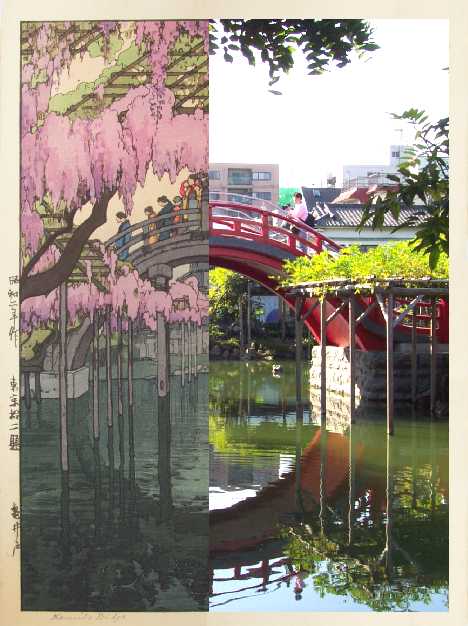
A "Composite View" of Tokyo's Kameido Tenjin Shrine
Hiroshi Yoshida's 1927 woodblock "Kameido" (left) -- 2003 Photograph (right)

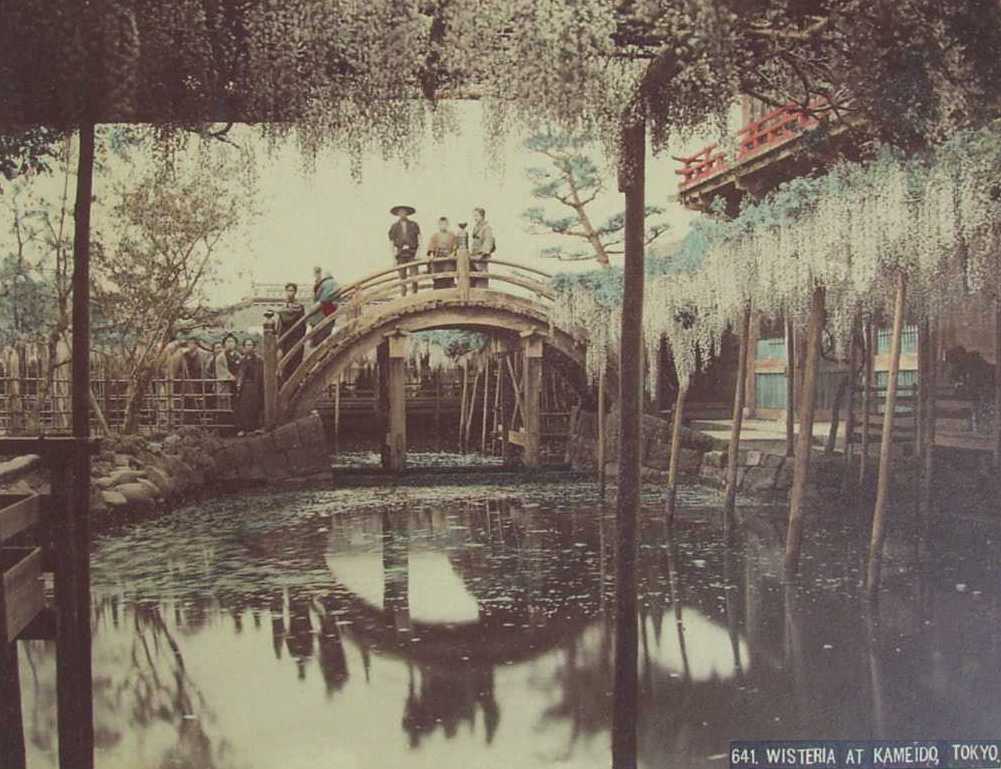
|
Viewing Kameido--Through the Eyes of Japanese Artists Of course, even to non-collectors or persons not broadly familiar with Japanese woodblock prints, Tokyo's Kameido Shrine is often still recognizable due to the well known "arched-bridge print" produced by Ando Hiroshige in 1856. Titled "Wisteria at Kameido Tenjin Shrine," this 65th print from Hiroshige's "One Hundred Famous Views of Edo" series is well known by millions of viewers including nearly any casual student of art. Solely for it's historic familiarity, we will view this print first--before then moving back in time to view a well over a dozen additional prints. Seen just below is Hiroshige's depiction showing both the wisteria blossoms and the steeply-arched "drum bridge" of this famous Tokyo landmark--this copy being a modern day "re-strike" of Hiroshige's 1856 original. 
Hiroshige's "Wisteria at Kameido Tenjin Shrine" (originally published 1856) Following now are a dozen-plus various artists' images of Tokyo's revered Kameido Shrine, shown in the approximate chronological order of their creation. We will offer little more in the form of words. As art, these many prints are adequately capable of speaking on their own. 
ANDO Hiroshige (1797-1858) "View of Kameido Tenmangu Shrine in Snow" (ca1833) -- An elevated perspective of Kameido. (Series: "Famous Views of the Eastern Capital (Edo)" ("Toto Meisho"); Publisher: Kinkakudo) 
ANDO Hiroshige (1797-1858) "Beauties at Kameido Shrine" (ca1834) -- A group of kimono-clad beauties resting at a tea break. (Series: "Famous Views of the Eastern Capital (Edo)" ("Toto Meisho"); Publisher: Kinkakudo) 
Hokusai (1760-1849) "Kameido" (1834) -- Stylistic clouds, viewers atop Kameido's "Drum Bridge." 
ANDO Hiroshige (1797-1858) "Kameido Tenjin Shrine" (1840) -- Snow with stylistic clouds above and below Kameido's "drum bridges." (Series: "Famous Views of Edo" ("Edo Meisho"); Publisher: Yamada-ya) 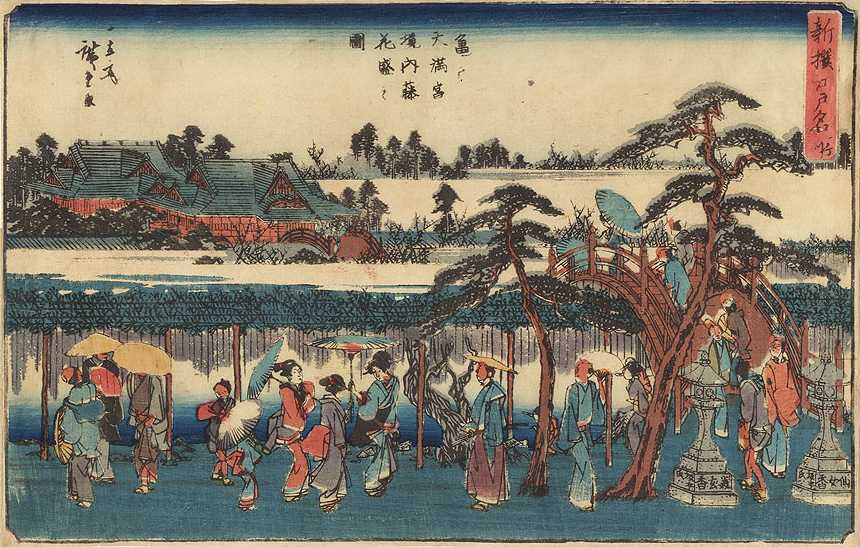
ANDO Hiroshige (1797-1858) "Wisterial in Bloom, Kameido Tenjin Shrine" (1840/42) -- Blooming wisteria and low clouds over Kameido's "drum bridges." (Series: "Famous Places in Edo" ("Edo Meisho"); Publisher: na) 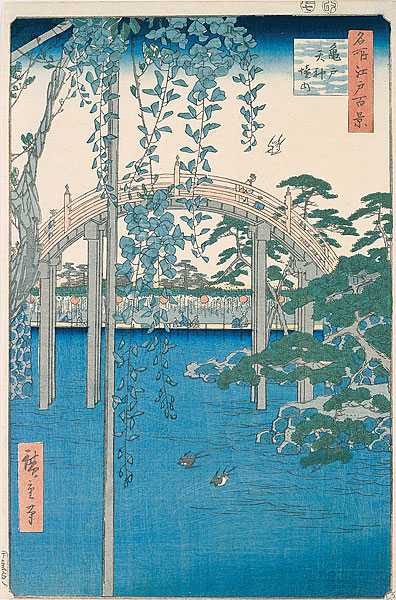
ANDO Hiroshige (1797-1858) "Wisteria at Kameido Tenjin Shrine" ("Kameido Tenjin Keidai") (1856) -- This an original edition printing of Hiroshige's famous image. (Series: "100 Famous Views of Edo" ("Meisho Edo Hyakkei"); Publisher: Uoei) 
ANDO Hiroshige (1797-1858) "Kameido Tenjin Shrine" (1851/53) -- An unusual perspective of Kameido's "drum bridge." (Series: "Famous Views of Edo" ("Edo Meisho"); Publisher: Yamada-ya) |


Hiroshige II (1829-1869) "Kameido" ca1862 -- Another elevated perspective of Kameido. (Series: "Famous Places of Edo" ("Edo Meisho") 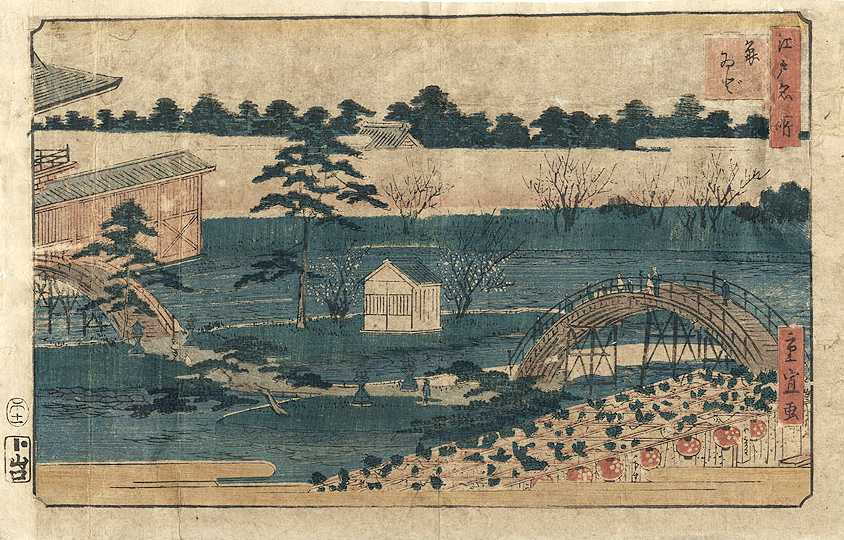
Hiroshige II (1829-1869) "Kameido" ca1859-62 -- And another elevated perspective of Kameido. (Series: "Famous Places of Edo" ("Edo Meisho") 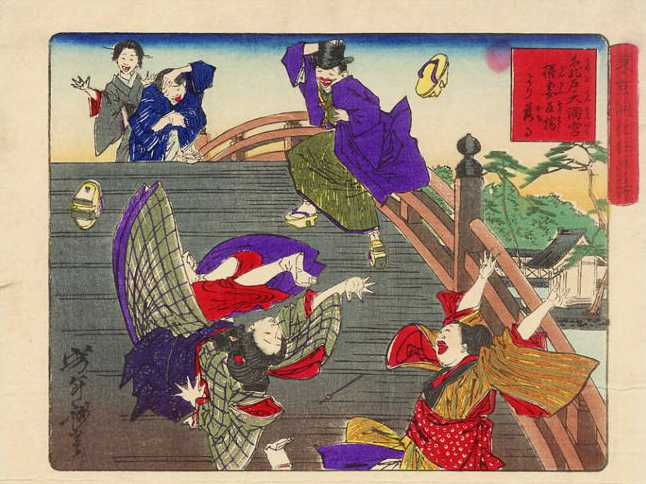
Yoshitoshi TAISO (1839-1892) "A Comic Scene" (1881) -- Another comic design--similar to Hirokage's 1859 image. (Series: "Comic Scenes of Tokyo" ("Tokyo Kaika Kyoga Meisho"); Publisher: Tsunashima Kamekichi) 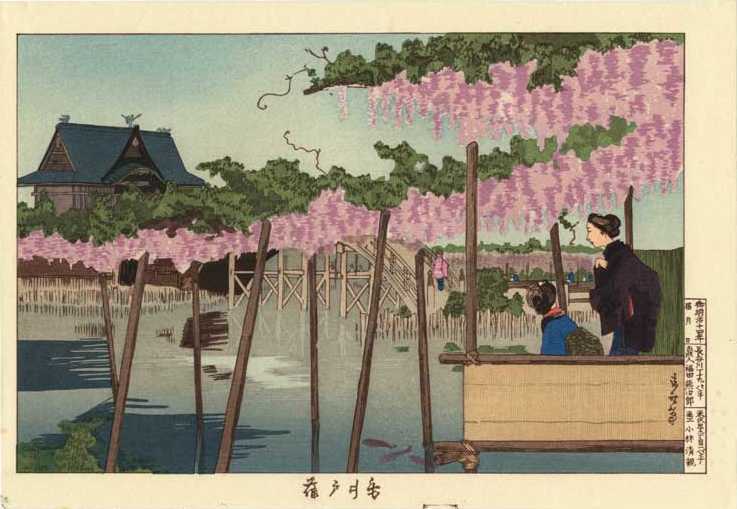
Kiyochika KOBAYASHI (1870-1917) "Kameido" (ca1880) -- Two beauties under wisteria. 
Kiyochika KOBAYASHI (1870-1917) "Kameido" (1884) -- An interesting perspective of Kameido's famous "Drum Bridge" (note the horizontal wooded runners added as "steps"). (Series: "One hundred views of Musashi" ("Musashi hyakkei no Uchi") 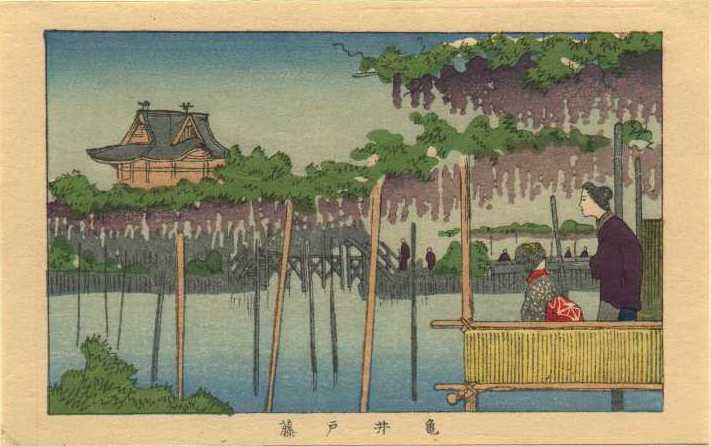
Inoue (Tankei) INOUE (1864-1889) "Kameido" (ca1880/85) -- A 5 x 7 print after Kiyochika's print. 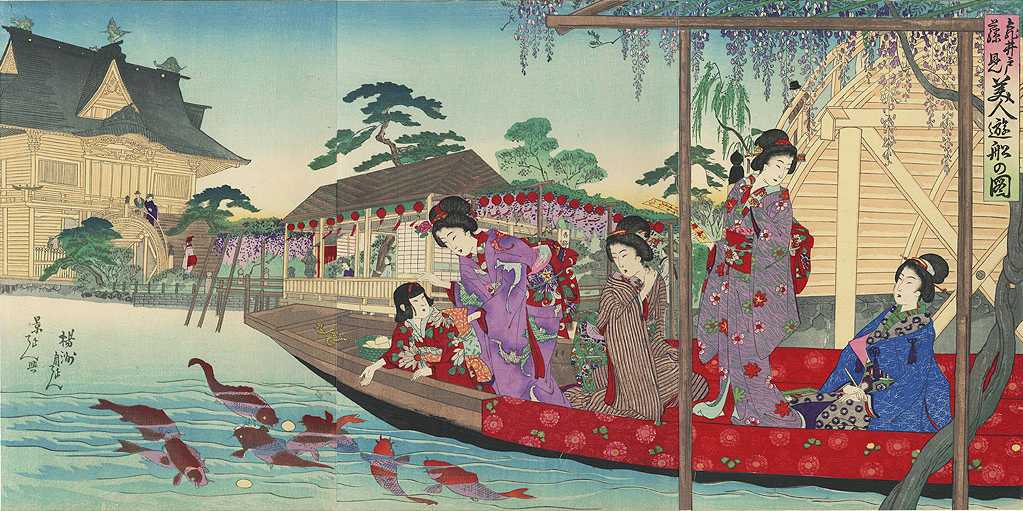
Chikanobu TOYOHARA (1832-1912) "Kameido" ca1890 -- Five beauties aboard a boat feeding koi. 
Chikanobu TOYOHARA (1832-1912) "Kameido" ca1890 -- Fishing at Kameido Shrine. |




OGATA, Gekko (1859-1920) "Kameido" (May 20, 1897) -- An unusual perspective of Kameido's "drum bridge." (Series: "Beauties Matched with Famous Sights" ("Bijin Meisho Awase"); Publisher: Matsuki Heikichi) 
Shoun YAMAMOTO (1870-1965) "Kameido" (untitled) (ca1900) -- A delightful original painting (on silk) of Kameido. (Series: "Women in Their Pursuits" -- One of 24 original paintings on silk.) 
Chikanobu TOYOHARA (1832-1912) "Viewing Koi at Kameido" (May 1903) -- Two beauties and child feeding koi. 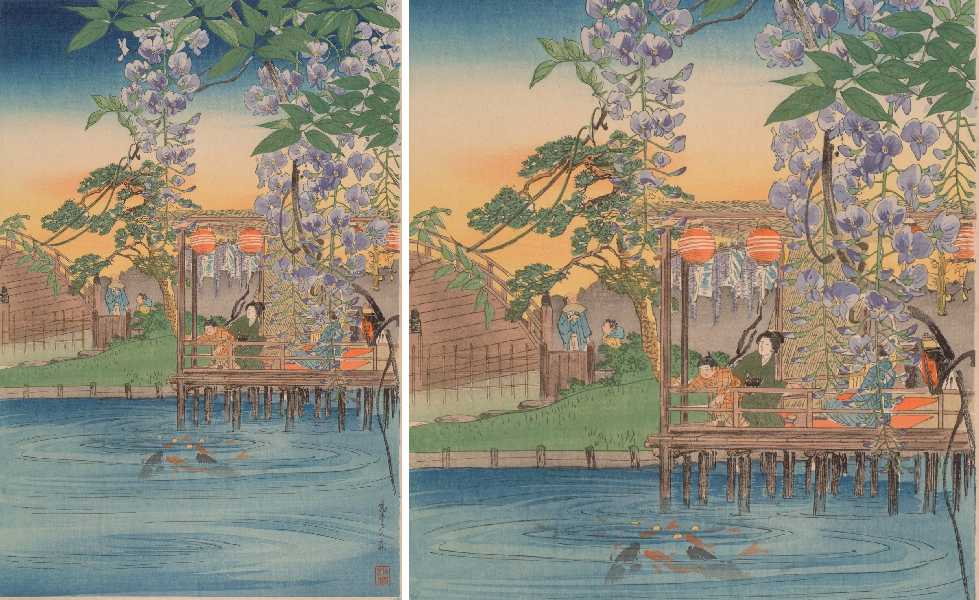
Shotei (Hiroaki TAKAHASHI) (1871-1945) "Wisteria at Kameido" (1909) -- A colorful distant view of children feeding Koi. |
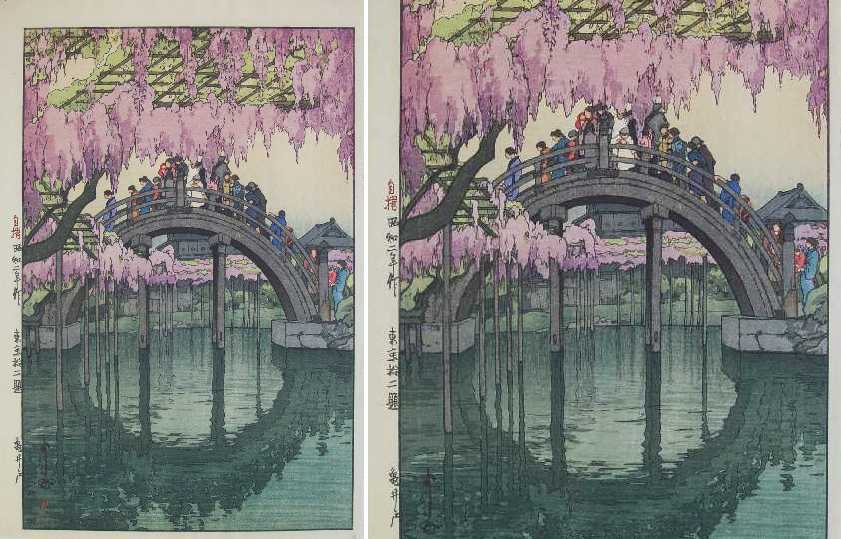
Hiroshi YOSHIDA (1876-1950) "Kameido Bridge" (1927) -- Yoshida's famous woodblock image of Kameido's "drum bridge." 
unread signature/seal (18??-19??) "Kameido Bridge" (ca1930) -- Apparently after (and in-the-style of) Yoshida's famous 1927 "Kameido Bridge" print. 
Helen HYDE (1868-1919) "Moon Bridge at Kameido" (1914) -- A close-up view of children playfully enjoying Kameido's "drum bridge." 
Hasui KAWASE (1883-1957) "Wisteria at Kameido" ("Kameido no Fuji") (May 1932) -- A "chuban-sized" print of densely flowering purple wisteria. (Publisher: Watanabe Shozaburo) 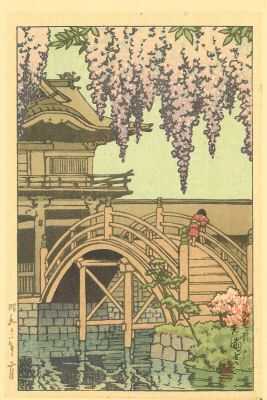
Hasui KAWASE (1883-1957) "Wisteria Blossom at Kameido Shrine, Tokyo"(1936) -- A delightful "postcard" print of Kameido. (Series: "Shinto and it's Architecture"; Publisher: Watanabe Shozaburo) 
Shiro KASAMATSU (1898-1991) "Wisteria at Kameido"(<1936) -- Another delightful "postcard" print of Kameido. (Publisher: Watanabe Shozaburo) 
Koitsu TSUCHIYA (1870-1949) "Kameido Bridge" 1933 -- A colorful view with dense purple wisteria. (Publisher: Doi Eiichi) 
Noel NOUET (1885-1969) "Kameido Shrine" (1936) -- Viewing Kameido through overhead wisteria. (Series: "Scenes of Tokyo Views" ("Tokyo Fukkei Zen Nijuyon-mai"); Publisher: Doi Eiichi) 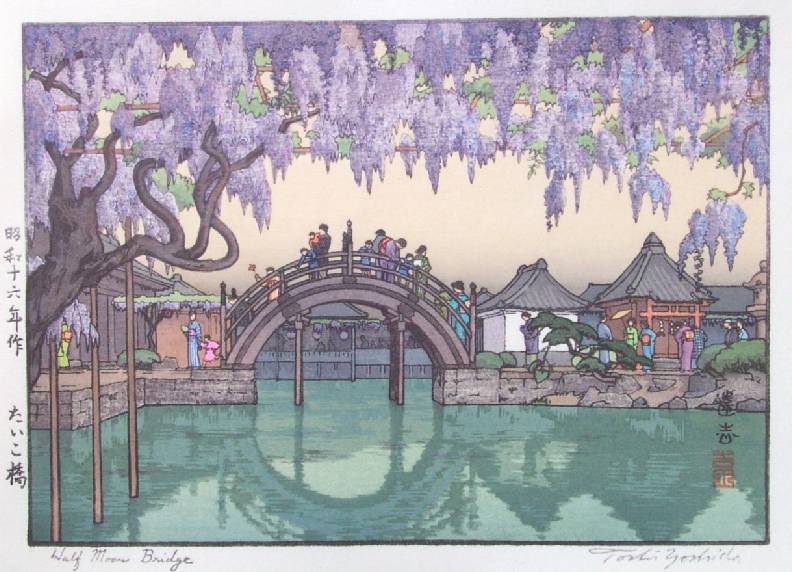
Toshi YOSHIDA (1911-1995) "Half-Moon Bridge" ("Taiko Bashi") (1941) -- Gorgeous wisteria overhanging Kameido's "drum bridge." 
Noel NOUET (1885-1969) "Kameido Shrine" (ca1944) -- Perhaps the last recorded artist's view of Kameido before WWII destruction. (Book "Tokyo Fifty Sketches" ("Tokyo"); Publisher: unknown; A wartime collection of Nouet's sketches.) 
Shiro KASAMATSU (1898-1991) "Taiko Bridge at Kameido Tenjin" (1951) -- A close-up perspective of Kameido's new bridge. (Grund #U-57; Publisher: Unsodo) 
Unknown "Taiko Bridge at Kameido Tenjin" (ca1951+) -- An "unsigned" postcard print, clearly a design copied from the above Kasamatsu print. 
Takao Sano "Wisteria and Drum Bridge at Kameido Tenjin Shrine" (2014) -- A modern print of today's Tokyo shrine. A Final "View" of Kameido Lest we forget that this article's intention is to show the many changing viewpoints of Japan's Kameido Shrine over the years--it has also been our observation that "the more things change over time...... the more they also seem to remain the same." This paradox--the blending of "modern Japan" with "old Japan"--perhaps more than anything else, is one of the delights that always await travelers who visit Japan for the very first time. As can be seen by the "composite photo" we've created just below, the passage of over a century's time has changed very little of the beauty of Japan's Kameido Tenjin Shrine. 
Another "Composite View" of Tokyo's Kameido Tenjin Shrine Meiji-era 1880-90 Photograph (left) -- 2003 Photograph (right) Conclusion As we stated in our earlier "Kameido" article--to collector's of Japanese woodblock prints, Japan's many shrines and picturesque views offer a stunningly endless variety of images available for collecting. To some collectors (this author included), a given location such as Kameido Shrine can become a stand-alone "sub-collection" comprised solely of various views of this same location. In the very near future, we will be featuring at least a couple of additional deserving locations within Japan, which have also proven over time to be popular "theme-collections" for collectors of Japanese woodblock prints. As both authors have traveled extensively in Japan, we will use our experiences in these future Ukiyoe-Gallery articles which will be presented in the same format: first a photo essay to both show and explain why these Japanese landmarks are famous, then a follow-up article showing how these locations have looked through the eyes of various Japanese artists over many decades of time. The "Look-alike" Sumiyoshi Shrine Bridge in Osaka Having invited the input of our readers who may own or be aware of additional woodblock print images of Tokyo's Kameido Shrine has unxepectely lead us to discover a very much "look-alike" arched bridge which is located at the Sumiyoshi Shrine in Osaka, Japan. Being quite an interesting and aesthetic structure, we've decided to add a few images of Sumiyoshi's drum-bridge for comparison. 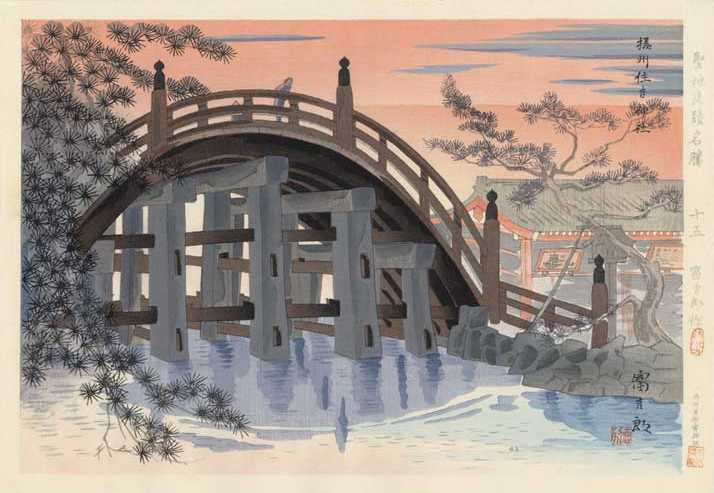
TOKURUKI, Tomikichiro (1902-2000) "Sumiyoshi Shrine" (1941) -- A view of Sumiyoshi Shrine's drum-bridge (in Osaka). (Series: "Famous, Sacred and Historical Places" ("Seichi Shiseki Meisho"); Publisher: Uchida Bijutsu Shoshi) 
ASANO, Takeji (1900-2002) "Sumiyoshi Shrine in Snow" (ca9154) -- A beautiful wintertime view of Sumiyoshi Shrine's drum-bridge. (Series: "Eight Views of Kinki" ("**"); Publisher: unk)
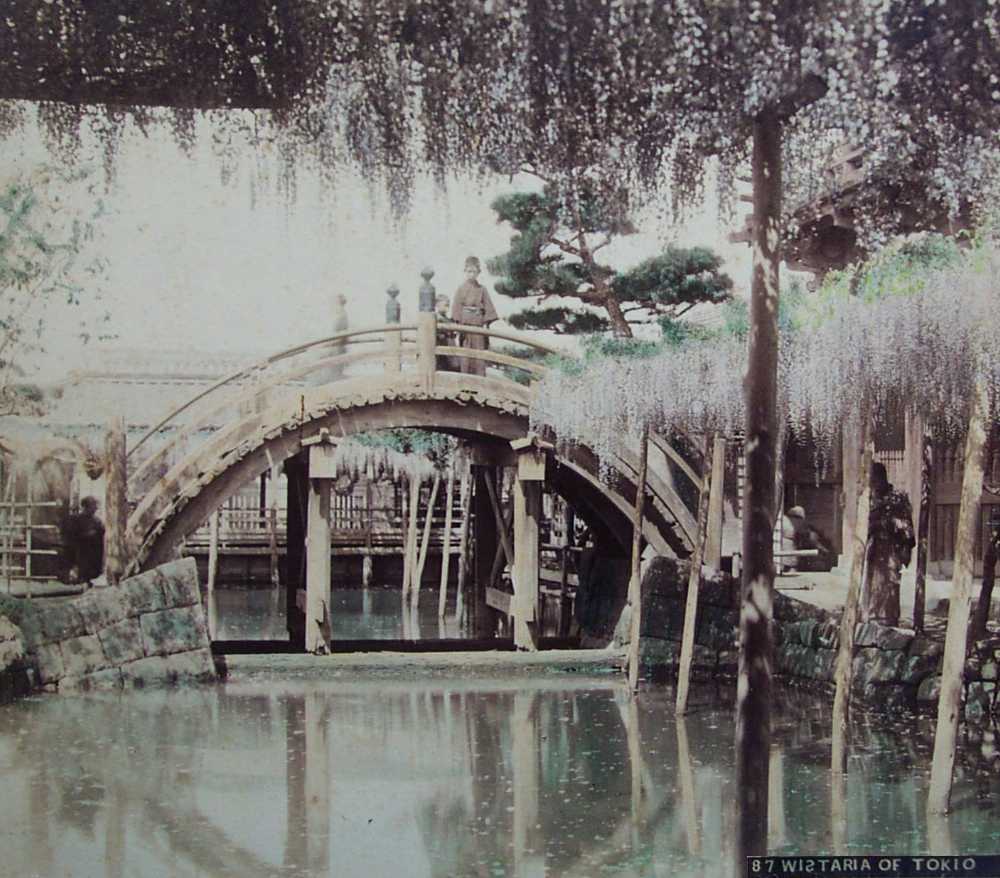
A Historically Accurate View inside Kameido's Grounds (photograph dated ca1880/90) 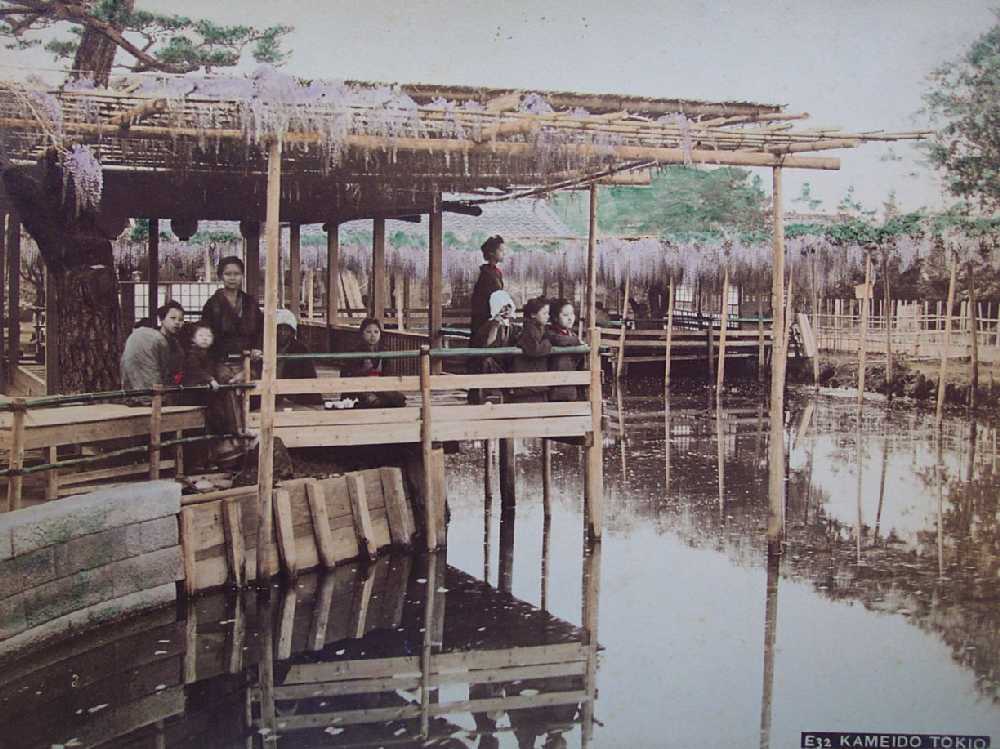
A Historically Accurate View inside Kameido's Grounds (photograph dated ca1880/90)
|